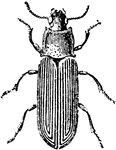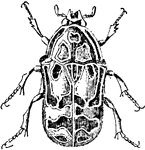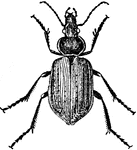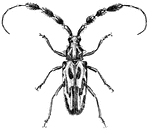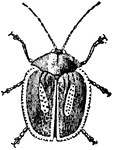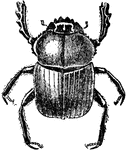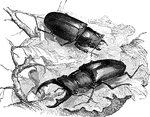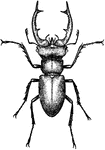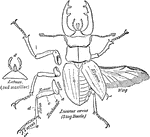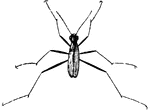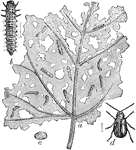
Grapevine Flea Beetle
The Grapevine Flea Beetle (Altica chalybea). "a, leaf infested with larvae; b, larva; c, cocoon; d,…

Four-Spotted Beetle
"Smallish insects, generally of a black color, with the elytra rather shorter than the body, which is…
!["One of the largest European beetles, the Brown Hydrophile, <em>Hydrous piceus</em>, which is common in ponds in some localities, belongs to [the philhydrida]." — Goodrich, 1859](https://etc.usf.edu/clipart/14600/14660/brownhydro_14660_mth.gif)
Giant Silver Beetle
"One of the largest European beetles, the Brown Hydrophile, Hydrous piceus, which is common…

Goliath Beetle
The African goliath-beetles and the american elephant-beetles are the largest of all insects.

Saw-Toothed Grain Beetle
The Saw-Toothed Grain Beetle (Oryzaephilus surinamensis) is a beetle of the Silvanidae family and is…

Great Diving Beetle
Dytiscus Harminieri, a genus of predatory, diving beetles that usually live in wetlands and ponds.

Great Diving Beetle
Dytiscus Harminieri, a genus of predatory, diving beetles that usually live in wetlands and ponds.
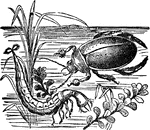
Great Diving Beetle
"A, Dytiscus Marginalis, or great Water-beetle; B, larva." — Chambers' Encyclopedia, 1875

Great Diving Beetle Adult and Larvae
"The Dyticus marginalis, a European species very common in ponds, attains a length of more…

Great Diving Beetle Female
"The Dyticus marginalis, a European species very common in ponds, attains a length of more…

Ground Beetle
"They are all of medium size, more or less oblong-oval in form, and mostly bronze-colored, rarely brown…

Hercules Beetle
The Hercules beetle (Dynastes hercules) is the most famous of the rhinoceros beetles. Native to the…
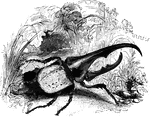
Hercules Beetle
"The hercules beetle is a native of Brazil, sometimes attaining a length of five inches." — Goodrich,…
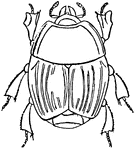
Hister Beetle
Hister Arcuatus, or clown beetle. Small, oval, shining, very hard, black bronzed or greenish beetles,…

Hister Beetle
Hister Bimaculatus, or clown beetle. Small, oval, shining, very hard, black bronzed or greenish beetles,…

Lard Beetles
"Received its specific name on account of the fondness exhibited by its curious larva for bacon." —…
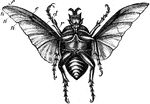
Large Beetle
"Under surface of large beetle, with deeply concave and comparatively small wings, shows that the nervures…
!["The [potato beetle larva] is pale yellow, or, rather, dusky-yellow, or freckled with minute black dots on the back; and there are two rows of larger black dots along each side; the legs are black."—Nicholson, 1884](https://etc.usf.edu/clipart/79000/79099/79099_potatolarva_mth.gif)
Larva of Potato Beetle
"The [potato beetle larva] is pale yellow, or, rather, dusky-yellow, or freckled with minute black dots…
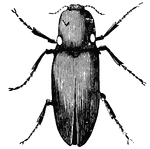
Lightning Spring Beetles
Beetles form a large group of insects that number over 300,000 species. They all have hard wings which…
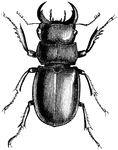
Longhorn Beetle
The longhorn beetles (Cerambycidae; also known as long-horned beetles or, more archaically, llongicorns)…
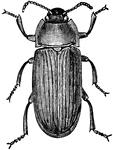
Mealworm Beetle
Mealworms are the larva form of the mealworm beetle, Tenebrio molitor, a species of darkling beetle.…
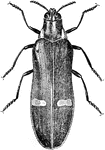
Metallic Beetle
"The Sternoxi include the Metallic Beetles, Buprestidae the most gorgeous of the coleopterous families.…

Metallic Beetle Larva
"The Sternoxi include the Metallic Beetles, Buprestidae the most gorgeous of the coleopterous families.…
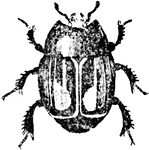
Mimic Beetle
"The Mimic Beetles seldom exceed one-third of an inch in length, and are of very solid consistence,…

Pine Beetle
This illustration shows the work of the destructive pine-bark beetle: a, a, a, a, characteristic forms…

Pine Beetle Stages
This illustration shows the destructive pine-bark beetle: a, adult beetle, enlarged; b, adult, natural…

Potato Beetle
Also known as Doryphora decemlineata. It is approximately 10 millimeters in length, with a bright yellow…

Sacred Beetle
"Many of the dung beetles, among which the Sacred Beetle of the Egyptians, Scarabus Aegyptiorum,…
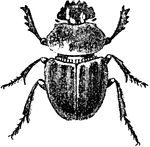
Sacred Beetle
"The Sacred Beetle of Egypt, Ateuchus sacer, somewhat resembles the Dor in form and habits. After depositing…

Sacred Beetle
An extensive genus of coleopterous insects tribes, and answering to the section Lamellicornes of Latereille.…

Scarab Beetle
"The S. nasicornis is a European species, common in gardens, and is noted for a pair of curious…
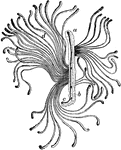
Spruce Beetle
"Galleries of the spruce-destroying beetle beneath the bark of a spruce tree." —Davison, 1906

Stag Beetle
Lucanus Dama, the most common stag beetle in which the mandibles of the male are much enlarged and sickle-shaped;…

Subangular Ground Beetle
"Subangular Ground-beetle (Aspidoglossa subangulata). Vertical line shows natural size."-Whitney, 1902

The Digestive Apparatus of a Beetle
The Annulosa and Mollusca are furnished with a distinct alimentary canal that does not open into the…

The Life Cycle of the Asparagus Beetle
Also known as crioceris asparagi. A-Beetle; B-Egg; C-Newly hatched larva; D-Full-grown larva; E-Pupa

Tiger Beetles
Beetles form a large group of insects that number over 300,000 species. They all have hard wings which…

Tiger Beetle
"Its distinguishing features are its small eyes, separate posterior coxae, and widely inflexed margin…
